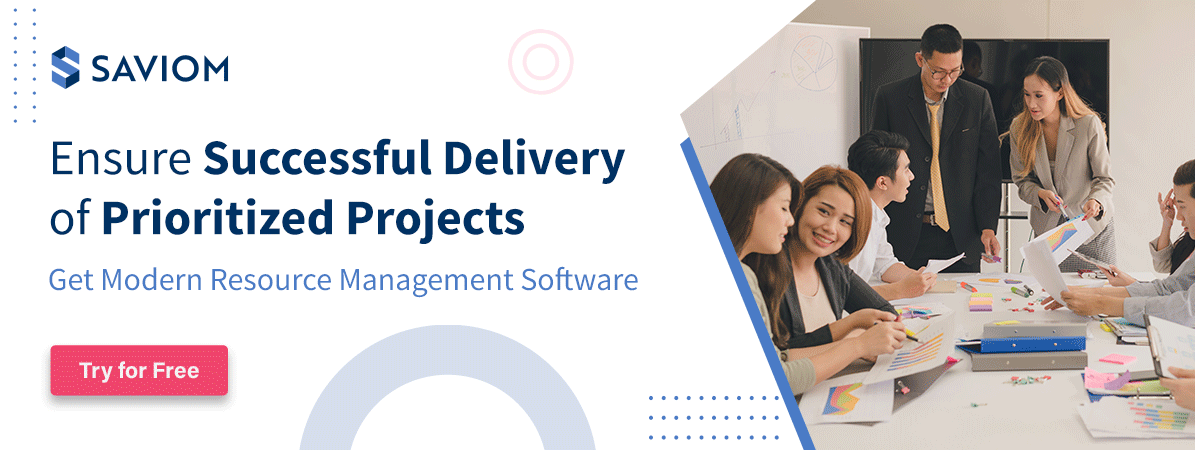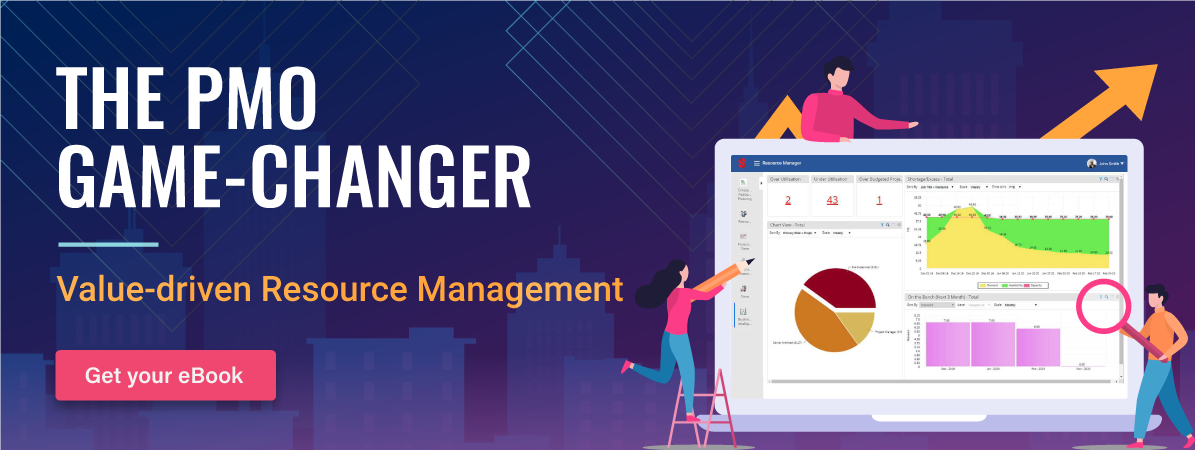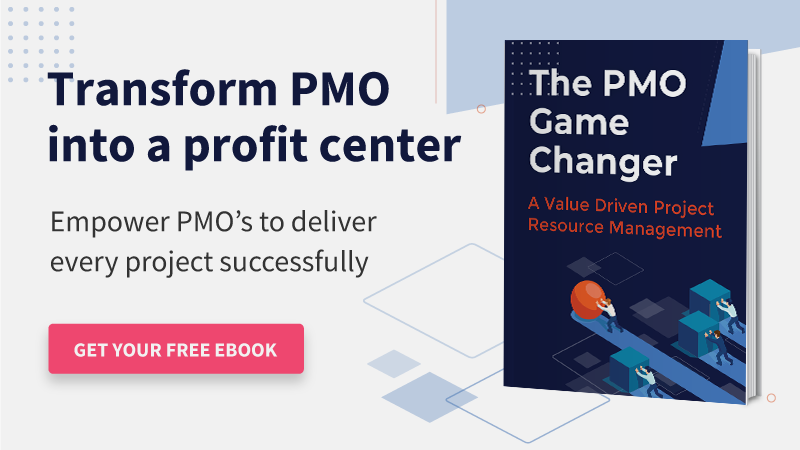In today’s competitive era, organizations are under constant pressure to deliver successful projects. Since resources are the driving factor behind a project’s success, one must utilize them to their full potential. However, this will not be possible in the absence of effective resource management software.
A central governance structure is essential to establish a framework for managing various projects. It oversees all different project-related metrics and ascertains that the projects are on track.
PMO plays a vital role in establishing the guidelines for different projects and portfolios. This blog will discuss what resource management practices will help a PMO ensure successful project delivery.
But first, let’s start with the definition.
What is a PMO?
A PMO (project management office) is a group that defines and maintains project management standards, documents project status, and guides an organization. Thus, it ensures effective management of the project metrics and successful delivery. Besides, it helps prioritize projects based on organizational goals, therefore, resulting in higher ROI.
However, in the present business world, the role of a PMO has evolved. It is more than just a hub for administrative functions. A PMO not only maintains project standards but it monitors projects and portfolio progress. It helps the top management to make data-driven decisions.
A modern PMO has the potential to become a value center and improve business profitability. From efficient utilization of the resources to achieving strategic objectives, an advanced PMO can take care of it all.
Read More: Top 10 Business Benefits of a Value Centric PMO
Three Types of a Project Management Office
There are three types of PMO, they are:
Supportive PMO
A supportive PMO has a consultative role. It has the collection of all projects in an organization. Based on that, it gives on-demand expertise, best practices, templates, training but with a low degree of control.
A supportive PMO works best in an organization where additional project control is not needed. It just works as the learning hub for project managers.
Controlling PMO
Controlling PMO monitors all the project activities. It checks if the project management tools, processes, and standards are judiciously implemented on the projects.
A controlling PMO ensures that the projects are conforming to the goals and objectives of the organization. Therefore, it has a certain degree of control over the projects. If the projects are getting derailed, then it can provide the necessary support to an extent.
Directive PMO
A directive PMO maintains a substantial degree of control in the management of projects. It does not just provide support or has little control over the projects, but it completely takes over the projects. Moreover, it manages every aspect of the project.
It assigns project managers who report back to the PMO. Thus, there is a high level of governance and consistency in the projects.
Best Practices of PMO Resource Management
A PMO is the nerve center of a project-driven company. It must monitor every project metric and ensure that the project remains on track. As resources are an essential investment for any company, one should manage them with utmost diligence. Therefore, the PMO needs to have an efficient resource management structure.
Here are some of the best practices for PMO resource management:
Select the right resource management tool
Often organizations rely on spreadsheets for resource planning. Though they may be beneficial and easy for preliminary scheduling, they become cumbersome and ineffective in the long run. Moreover, in matrix organizations, resources are based in different departments across countries. Silos of spreadsheets and home-grown tools cannot provide a single version of the truth across the enterprise. Therefore, it gets challenging to schedule resources since there is minimum visibility.
A resource management tool helps maintain every resource-related data on a single platform. It provides 360-degree visibility across the organization. It helps evaluate resource availability and also assists in bridging the capacity gap if necessary. As a result, one can allocate the best available resources to the right task at the correct cost. Moreover, managers can find low-cost global resources and ensure successful project delivery without compromising quality.
Read More: How to Select the Best Resource Management Solution for your Business
Prioritize projects based on profitability
For a project-based company, its profitability depends on the success of the projects that it delivers. To achieve that, PMO’s are responsible for prioritizing projects based on the company’s goals, and objectives will generate maximum ROI. To do so, the PMO must:
- Select projects based on business objectives.
- Ensure that the project goals align with the corporate strategies.
- Allocate resources based on project prioritization.
- Track resource utilization for maximum productivity.
- Monitor project progress at every stage to ensure it is on track.
- Evaluate project impact on clients.
Foresee project resource demand in advance
Forecasting project resources beforehand helps avoid last-minute firefighting activities. Thus, it helps eliminate the excess resource cost and ensures that the budget is intact. Long before the project starts, managers can ensure that they have the right resources for the tasks. When resources are not forecasted in advance, it results in suboptimal allocation, which subsequently affects project quality.
A resource forecasting tool provides visibility into the future resource demand based on which managers can forward plan pipeline projects. Moreover, they can also find the resource excesses and shortfalls and take appropriate measures to bridge the capacity gap. For instance, if there is an excess of resources, then project timelines can be brought forward. Similarly, resource shortages can be controlled by providing training or by taking appropriate resourcing measures.
Read More: What is Resource Forecasting? An Ultimate Guide for Project Managers
Assess skill set of available resources
The PMO must ascertain that the resources have the right skillset before they are scheduled for the projects. For instance, if an under-skilled resource is allocated to a project, it will cause delays as the resource will require time to acquire the knowledge and level of expertise. Moreover, extra training has to be provided to bring that resource to the optimal level. As a result, it leads to budget and time overruns.
On the other hand, if an over-skilled resource is deployed to the project, it will make the resource feel less valued and eventually blow up the project costs. In addition, it may lead to work-related conflicts or resource attrition. Thus, proper assessment of the resource skill set is necessary for the overall success of the project.
Publish open positions for internal resources to apply
Publishing open positions serves two purposes. Firstly, it empowers resources to select a project of their interest. Secondly, it saves resource managers time and effort to look into the resource pool using many filters. Therefore, when a resource manager selects the ideal pool of resources from the interested candidates, they show greater interest in the project, leading to exemplary results.
A modern resource management solution helps PMOs to publish open positions when necessary. That way, resources can apply for multiple vacancies and, after evaluation, can be allocated to those tasks. It will result in an inclusive culture as resources can work in their area of interest. Moreover, it will also enhance task ownership and productivity.
Read More: Using the Resource-based View Strategy for a Competitive Advantage
Optimize resource schedules for better utilization
Under or overutilization of resources has various adverse effects on the delivery of the projects. Both these factors lead to missed deadlines, lower productivity, employee burnouts, and even attritions. Therefore, optimal utilization is necessary to ensure that none of these mishaps happen.
Resource leveling and smoothing are two techniques that managers may take to optimize schedules. For instance, resource leveling means reshuffling the timeline as per the resource schedule. This can only be possible if the client permits elongating the duration. On the other hand, resource smoothing is optimizing the schedule without hampering the period. For example, if a resource is scheduled for 8 hours per day. But he/she can do the work in 6 hours. Thus, the manager can reduce the schedule to 6 hours per day. It will help in ensuring that the resource is used optimally.
Clearly state the roles and responsibilities of resources
A lack of clarity around roles and responsibilities creates confusion among the project team members. When resources don’t have complete knowledge about their roles and responsibilities, it creates unnecessary conflicts. Moreover, it may also result in role overlaps.
The PMO must create a clear role description for every project member. A comprehensible report helps in three ways:
- Firstly, it describes the ideal candidate for the job. This information can be used as a checklist when considering internal hires or seeking external candidates.
- Secondly, they assist the resources to focus on the right areas of the positions. It helps them in understanding what is asked of them. Besides, they realize how their role fits into the bigger picture. That way, they are more productive and better engaged.
- Thirdly, it can also assist the team members in identifying their professional development grounds about the knowledge, skills, and competencies required for their project role.
Read More: What is PMO: Roles, Responsibilities, Types & Benefits
Conduct training and development programs as required
Providing training and development programs to project team members helps in developing their competencies. In addition, systematic and integrated professional development training provides them with the expertise needed for successful project delivery.
PMO training programs begin with creating performance metrics for better evaluation. A PMO development program helps in getting the best out of every team member. Thus, they can provide the best results when needed. Moreover, it also assists them in making the best use of their slack time. For instance, when resources end up on the bench, their billable utilization gets affected. These programs help the resources to hone their skills and eliminate any professional lackings. Thus, making them better at their jobs.
Develop and manage a resource risk management plan
All projects depend on highly skilled resources to carry out the most critical tasks. But what if any of the essential resources retires from the company or leaves the project midway? Every PMO puts in a lot of effort in creating a formidable project team. However, many do not have a backup plan if a vital resource leaves the organization or remains absent for an extended period.
A PMO must review the staffing levels and develop a resource-risk plan for these situations. Here is a rundown of the ways to create a vital resource risk management plan:
- Determine the critical resource demands in the organization and predict the potential vacant positions.
- Develop a succession plan for critical resources who may retire in the future.
- Ascertain the responsibilities, competencies, and requirements for those positions.
- Evaluate the existing resources or hire new resources if needed.
- Find resources who have the potential to grow into the roles.
- Establish a resource pool of workers who can mitigate the skill gaps.
Read More: How to Mitigate Resource Risk in Project Management?
Build reusable assets and apply them to different projects
Resources get better at their jobs with experience. When the PMO uses a resource for a definite project, it provides a learning opportunity for the resource. It helps in eliminating all the skill gaps and makes the resources more accustomed to the organizational standards. Thus, it assists in increasing their potential.
Thus, when a similar project comes up, PMOs can allocate these resources. As they have previous experience and the right skills, they will be the perfect match for it. Thus, it helps in the successful delivery of the project. Moreover, it assists in avoiding extra resourcing costs, time overruns, etc.
Read More: PMO resource management challenges: What you need to know
Conclusion
An efficient resource management solution helps maintain the most precious assets of a company, i.e., resources. Following these best practices, a PMO can significantly enhance resource management. It will help in improving resource productivity, utilization, and engagement.
In a nutshell, with the help of these steps, a PMO can:
- Maintain the project management standards.
- Predict resource demands and bridge skill gaps.
- Allocate the right resources to the right tasks at the right time.
- Eliminate resourcing costs significantly.
- Beat market volatility with the proper development programs.
- Deliver projects within the stipulated time and budget.
SAVIOM Solution
SAVIOM has over 20 years of experience helping multinational clients manage their resources efficiently and effectively. With over 20 years of experience, this Australian-based MNC has a global presence across 50 countries and has helped 100+ clients meet their specific business goals. Saviom also provides tools for project portfolio management, professional service automation, and workforce planning software. So, SAVIOM can help your business to establish an efficient system geared towards your specific business challenges.












